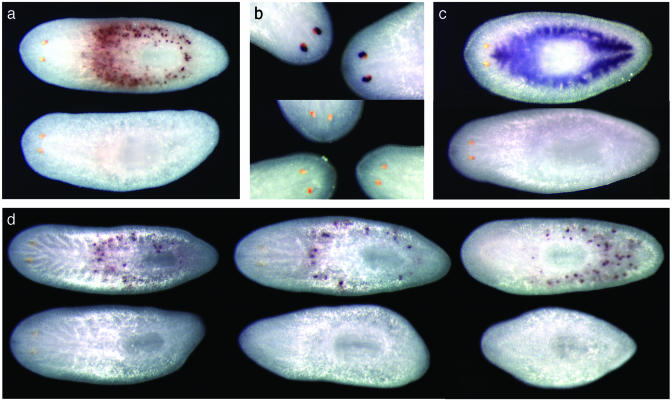Fig. 2.

Inhibition of gene expression in planarians by ingestion of bacterially expressed dsRNA. (a) Specific inhibition of a centrally expressed MP. Both animals were fed bacteria expressing a construct targeting an astacin-like MP (B10). One animal (Upper) was hybridized to detect the transcript encoded by another centrally expressed MP (collagenase-like B2; positive signal in 10/10), whereas another animal (Lower) was hybridized to detect B10 (no detectable expression in 32/36; significantly reduced expression in 3/36). When MP B2 was targeted, and animals were fixed and hybridized to detect B2 transcripts, no signal was detected in 39/47 samples; 8/47 showed a strong reduction of transcript (data not shown). (b) Inhibition of photoreceptor expression of arrestin E30. (Upper) The animals were fed bacteria targeting a gut-specific gene; photoreceptor expression of E30 is normal (7/7). (Lower) The animals were fed a construct targeting photoreceptor-specific arrestin (reduction observed in 17/17). (c) Inhibition of expression in the gastrovascular system. Hybridization with gastrovascular-specific probe D14.38. (Upper) The animal was fed a construct targeting a photo-receptor-specific gene (4/4 positive). (Lower) The animal was fed a construct targeting D14.38 (no signal in 44/44 worms). (d) Inhibition persists throughout the regenerative process. (Upper) The animals were fed a control bacterial strain, containing the vector alone. (Lower) The animals were fed bacteria targeting astacin-like MP B10. Three days after feeding, planarians were cut into three parts and allowed to regenerate for 9 days [12 days after the last feeding; animals are regenerated from head fragments (Left), trunk fragments (Center), and tail fragments (Right)]. The control worms reestablished expression of B10 (positive signal in 6/6 treated worms), whereas in the experimental worms B10 expression was inhibited below detectable levels (no detectable expression in 14/14 worms).
